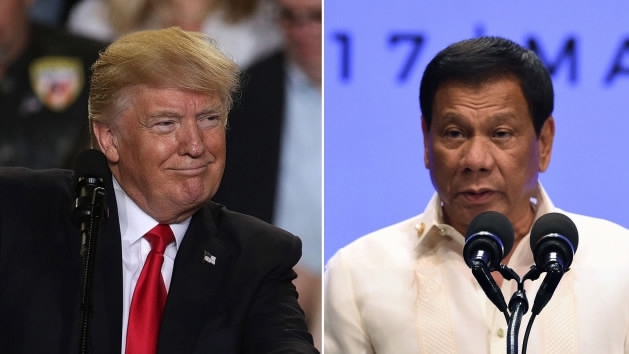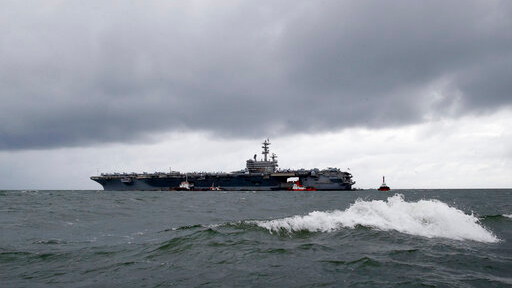
Editor's note: Tom Fowdy is a British political and international relations analyst and a graduate of Durham and Oxford universities. He writes on topics pertaining to China, the DPRK, Britain and the U.S. The article reflects the author's opinions, and not necessarily the views of CGTN.
Philippines President Rodrigo Duterte on August 4 banned his naval forces from participating in joint exercises with the U.S. in the South China Sea, a move which will surely disappoint the White House's recent intentions to stir up trouble in the region against Beijing. The country's Defense Secretary Delfin Lorenzana stated: "President Rodrigo Duterte has a standing order to us, to me, that we should not involve ourselves in naval exercises in the South China Sea except our national waters, the 12-mile distance from our shores."
The move signals the country is unwilling to directly challenge Beijing's claims of sovereignty over the waters, despite Washington having sought to incite a pushback in the region against China last month by unilaterally declaring Beijing's position on sea as illegal. Needless to say, this is not the reaction U.S. Secretary of State Mike Pompeo was expecting.
President Duterte has directly set out over the past few weeks that the costs for confrontation on this matter are too high, that it would risk war and in turn diplomacy is the only way forwards. The U.S. has miscalculated by assuming regional partners would be seeking confrontation, they aren't. Washington is seemingly overestimating its hand.
The U.S. have deliberately sought to ramp up tensions in the South China Sea as part of the multi-frontier assault they are making towards Beijing in what is widely depicted to be an attempt to start a new Cold War. In choosing this to raise the stakes on issue and declare the Nine Dash Line as illegitimate, U.S. policymakers had several strategic objectives in mind.
First of all, it is an escalation of Washington's Indo-Pacific strategy which relates to a broader attempt to foster military cooperation and containment around China's periphery.
Secondly, they believed by deliberately pouring petrol on territorial disputes between China and regional parties such as the Philippines, that they could drive a wedge between these countries and push a deterioration in relations, forcing them to rely on more U.S. military support.
Then thirdly, they also believed by deliberately taking these countries sides against China, they would empower them diplomatically to be more provocative towards Beijing in their disputes (as what initially happened under the Barack Obama administration as the Pivot to Asia came in), thus it seemed like "a catch all" attempt to push the China threat and containment mantra.

Rain clouds loom over the U.S. aircraft carrier USS Ronald Reagan as it is anchored off Manila Bay, the Philippines, August 7, 2019. /AP
Rain clouds loom over the U.S. aircraft carrier USS Ronald Reagan as it is anchored off Manila Bay, the Philippines, August 7, 2019. /AP
But that might not be working out as planned. The Philippines under Rodrigo Duterte pursues a realist foreign policy which carefully assesses the balance of economic and strategic power in the region. He astutely recognizes that his country has a great deal to lose from going on a collision course with Beijing and as a result, he chooses to hedge between the U.S. and China rather than being as typical, a devout ally as the Philippines has been.
He acknowledged last week that he cannot change China's sovereign claims, commenting: "Unless we are prepared to go to war, I would suggest that we better just cool off and treat this as a diplomatic endeavor."
As a result, Manila is not taking Pompeo's bait. While the country reversed their exit from the Visiting Forces Agreement with the U.S. which was first announced on February 11, 2020, and will participate in other military exercises away from Chinese territory, it is quite clear that escalating tensions with China is seen as a non-starter that cannot bring any tangible benefits to the country.
Other Southeast Asian nations, including Vietnam and Malaysia, are likely to take similar positions. Even if they disagree, from a strategic point of view they recognize that Chinese sovereignty over the South China Sea is a practical reality and therefore, will pursue diplomatic rather than military means to secure their national interests.
This may suggest the U.S. are dramatically overplaying their hand. Arrogantly assuming "the tide is turning" against China, it is not hard to recognize that Pompeo may be drastically complacent and even delusional in the assumption that other countries will leap into his anti-Beijing crusade, the move to up the ante in the South China Sea was very much an attempt to do so, a deliberate and naked attempt to disrupt regional stability.
However, Rodrigo Duterte's abrupt aborting of a naval exercise in the region ought to be a sure sign that this was not going to be the case, acknowledging the fundamental shortcomings of such an approach from a perspective of national interest. With the U.S. having miscalculated, Beijing now has an opportunity to negotiate with regional countries and isolate Washington's position.
(If you want to contribute and have specific expertise, please contact us at opinions@cgtn.com.)